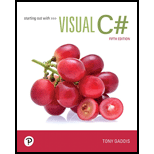
Concept explainers
PERSON AND CUSTOMER Classes
Design a class named Person with properties for holding a person’s name, address, and telephone number. Next, design a class named Customer, which is derived from the Person class. The Customer class should have a property for a customer number and a Boolean property indicating whether the customer wishes to be on a mailing list. Demonstrate an object of the Customer class in a simple application.
Trending nowThis is a popular solution!

Chapter 11 Solutions
Pearson eText for Starting out with Visual C# -- Instant Access (Pearson+)
Additional Engineering Textbook Solutions
Vector Mechanics For Engineers
Database Concepts (8th Edition)
Modern Database Management
Mechanics of Materials (10th Edition)
HEAT+MASS TRANSFER:FUND.+APPL.
Java: An Introduction to Problem Solving and Programming (8th Edition)
- Année scolaire: 2024/2025 Collège SMARA Devoir à domicile 1 semestre 2 Prof: NILAJ PHYSIQUE CHIMIE Nom et Prénom: Niveau: 3APIC Exercice 1: Durée: 1 heure 1) Donner la définition des termes suivantes? Le Mouvement : La vitesse moyenne: 2) Répondre par « Vrai » ou «> Un objet peut être en mouvement et au repos Si la vitesse est constante, le mouvement sera uniforme. 3) Compléter les phrases par les termes qui conviennent : Pour déterminer le mouvement ou le repos d'un objet, vous devez choisir un autre objet appelé le d'un point d'un corps mobile est l'ensemble des positions qu'il occupe durant son mouvement. Il y a trois types de trajectoires: circulaire. La distance de freinage dépend de 4) Cocher la bonne réponse? > La relation entre la vitesse, la distance et le temps: d Vm = dxt > L'unité internationale de la vitesse moyenne est : m/s 5) On considère la figure suivante : Compléter le tableau par les mots suivants : En mouvement au repos A C Km/h et et l' m. s-1 15 A B C Sol…arrow_forward5. Here is a tree corresponding to T(64) for an unknown recurrence relation: 32 + lg 64 8+ lg 16 2+ lg 4 2+lg4 2+lg4 8+ lg 16 2+lg4 7 7 7 7 7 7 7 7 Fill in the details for the corresponding recurrence relation: T(n) = T(n/4)+ T(1)= Put scratch work below. Scratch work is not graded but may be used for regrade partial credit.arrow_forwardTop screenshot is question, the rest are examples and explinations.arrow_forward
- Activity Time (days) Predecessors Earliest Expected Completion Time (TE) Latest Expected Completion Time (TE) 1 4 2 5 1 3456782222 6 1 7 1 4 4 6 2,3 5 3 5 5,7 9 4 7 10 3 6,9 11 5 8,9,10 12 4 11 Slack Critical Path? Yes or Noarrow_forwardI would like to know about the following concepts: 1. defragmentation 2. disk management 3. hardware RAIDarrow_forwardNode.js, Express, and Nunjucks Templates?arrow_forward
- CIT244 Program Project 3 Assignment As with any assigned program, do not wait until the last minute to start. Start early in the week the program is due so you can ask questions if you get stuck Node.js and Express and Nunjucks Templates We have gotten to the good stuff. There is a program similar to this assignment given as the last example in the lecture notes for the week that discusses node static files. This program will take more time that previous assignments. There are several examples you should study first, particularly the pizza order example program available in the examples programs folder for the week discussing static files. You should study and run the pizza order program before trying this program. The pseudo-company is called Sun or Fun, which offers cheap flights from Louisville to either Miami or Vegas. Here's a video of how it should work. NOTE: You will hear or see references to Handlebars in this video. We used to use Handlebars, but it will be Nunjucks that we…arrow_forwardhow to write the expression for the outputarrow_forwardPlease answer the exercise below(C programme)arrow_forward
- I need to list and know about some local storage options available in Windows Server 2019, thank youarrow_forwardPlease answer both Exercise 1 and2(these questions are not GRADED)arrow_forwardDiscussion 1. Comment on your results. 2. Compare between the practical and theoretical results. 3. Find VB, Vc on the figure below: 3V V₁₁ R₁ B IR, R, IR, R www ΙΚΩ www www I 1.5KQ 18₁ 82002 R₁ 3.3KQ R₂ 2.2KQ E Darrow_forward
- Programming Logic & Design ComprehensiveComputer ScienceISBN:9781337669405Author:FARRELLPublisher:Cengage
 EBK JAVA PROGRAMMINGComputer ScienceISBN:9781337671385Author:FARRELLPublisher:CENGAGE LEARNING - CONSIGNMENT
EBK JAVA PROGRAMMINGComputer ScienceISBN:9781337671385Author:FARRELLPublisher:CENGAGE LEARNING - CONSIGNMENT Microsoft Visual C#Computer ScienceISBN:9781337102100Author:Joyce, Farrell.Publisher:Cengage Learning,
Microsoft Visual C#Computer ScienceISBN:9781337102100Author:Joyce, Farrell.Publisher:Cengage Learning,  C++ Programming: From Problem Analysis to Program...Computer ScienceISBN:9781337102087Author:D. S. MalikPublisher:Cengage Learning
C++ Programming: From Problem Analysis to Program...Computer ScienceISBN:9781337102087Author:D. S. MalikPublisher:Cengage Learning Programming with Microsoft Visual Basic 2017Computer ScienceISBN:9781337102124Author:Diane ZakPublisher:Cengage Learning
Programming with Microsoft Visual Basic 2017Computer ScienceISBN:9781337102124Author:Diane ZakPublisher:Cengage Learning Systems ArchitectureComputer ScienceISBN:9781305080195Author:Stephen D. BurdPublisher:Cengage Learning
Systems ArchitectureComputer ScienceISBN:9781305080195Author:Stephen D. BurdPublisher:Cengage Learning





